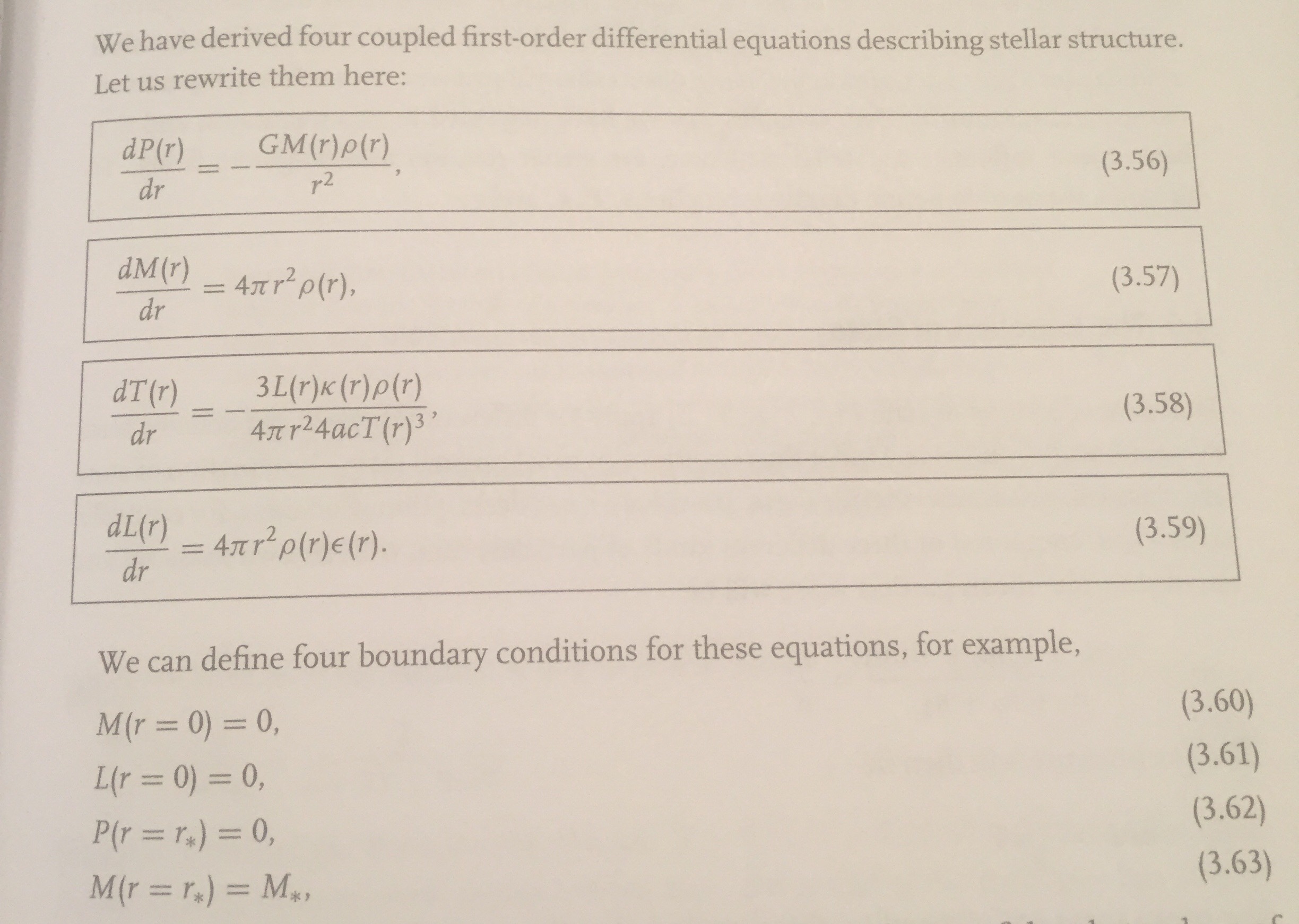Question
Consider a hypothetical star of radius R, with density rho that is constant,i.e., independent of radius. The star is composed of a classical, nonrelativistic, ideal gas of fully ionized hydrogen. Solve the equations of stellar structure for the pressure profile, P(r), with the boundary condition P(R)=0
An image of the stellar structure equations is attached.

Transcribed Image Text:We have derived four coupled first-order differential equations describing stellar structure.
Let us rewrite them here:
dP(r)
GM(r)p(r)
(3.56)
dr
r2
dM(r)
= 4rr²p(r),
dr
(3.57)
dT(r)
3L(r)« (r)p(r)
(3.58)
dr
4Jt p24acT(r)³’
dL(r)
(3.59)
4Jt r? p(r)e(r).
dr
We can define four boundary conditions for these equations, for example,
(3.60)
M(r = 0) = 0,
%3D
%3D
(3.61)
L(r = 0) = 0,
%3D
(3.62)
P(r = r.) = 0,
(3.63)
M(r = r.) = M,,
%3D
Expert Solution
This question has been solved!
Explore an expertly crafted, step-by-step solution for a thorough understanding of key concepts.
This is a popular solution
Trending nowThis is a popular solution!
Step by stepSolved in 3 steps with 4 images

Knowledge Booster
Similar questions
- ext cenb. Consider a system whose states are given in term of complete and orthonormal set of kets |1>, |2 >, [3 >,14 > as follows: 1 1p >= |1 > + 기2 > +2|3 > + 기4 > i 214> Where the kets |n > are eigenstates of an observable A defined on the system as follows: 2 A]n > = na|n > with n = 1,2,3,4 and with a a constant number. have 4) eiyen vealue 1. If A is measured, which values will be found and with which probabilities? 2. Find the expectation value of A for the state |Ø >. 3. Assume that the state 14> is found after the measurement of A. If A is measured again immediately, which states will be found and with which probabilities? 4. Find the expectation value of A if the system is in the state |4 >. 5. Assume B another observable defined on the system, which is compatible with A. Write the uncertainty inequality between A and B. 6. If B is measured, which states will be found and with which probabilities?arrow_forwardWhat does population vector, Π=(P1,P2,P3r,P3w)T mean ? How do this formula describe the overall state probability? (there are state 1, state 2 and state 3w, 3r)arrow_forward(a) Prove the "vertical angle hypothesis" (I. 15): opposing angles are congruent if two lines cut each other. (Hint: You'll need to use postulate 4 about right angles in this case.) ) (b) Complete the proof of the Exterior Angle Theorem using section (a): illustrate why beta < alphaarrow_forward
- Which one of the following statements about the exchange energy of the few lowest excited states of helium, in which the two electrons are in different subshells, is incorrect? Select an answer and submit. For keyboard navigation, use the up/down arrow keys to select an answer. b с d e In the absence of the exchange energy, the degeneracy between 1s¹2s¹ and 1s¹2p¹ configurations would only be lifted by relativistic corrections. For a given configuration and L the exchange energy favours (ie the energy is lower for) S-1 compared with S=0 O For a given configuration and L the exchange energy favours states that are spatially anti-symmetric The exchange energy gives larger shifts in the levels than relativistic corrections L, S remain good quantum numbers in the presence of the exchange energyarrow_forwardConsider a uniform source of neutrons in a diffusive, non-absorbing medium located between two concentric spheres of radii a and b > a. The inner part of the sphere of radius a contains a perfectly absorbing material; the outer surface of the sphere of radius b is a perfect mirror (albedo equal to one). Derive an expression for the flux between a and b.arrow_forwardFind the number density N/V for Bose-Einstein condensation to occur in helium at room temperature (293 K). Compare your answer with the number density for an ideal gas at room temperature at 1 atmosphere pressure.arrow_forward
- An electron with an initial kinetic energy of 1.542 eV (in a region with 1.095 eV potential energy) is incident on a potential step (extending from x=0 to ∞) to V=2.381 eV. What is the transmission probability (in %)? FYI: If we had a travelling wave arriving at a similar potential DROP, then k1 (for x<0) would be real and the symmetry of R=(k1-k2)2/(k1+k2)2 implies reflection/transmission are the same as a potential RISE with the same energies but k1 and k2 swapped.arrow_forwardPlease helparrow_forwardBook: Classical Dynamics of Particles and Systems Topic: Calculus of Variations Please answer in a detailed solution. For study purposes. Thanks.arrow_forward
arrow_back_ios
arrow_forward_ios